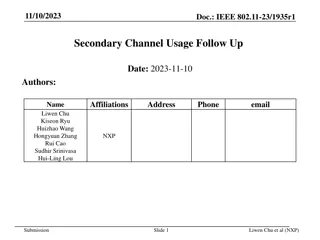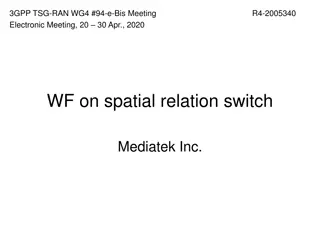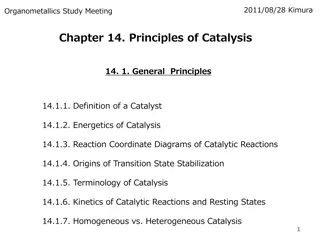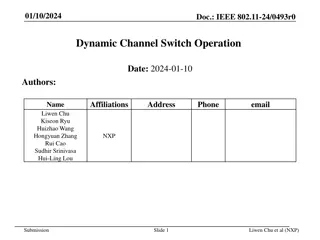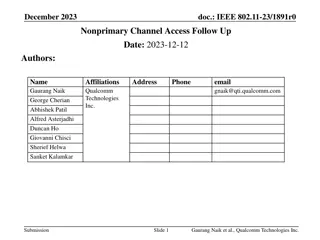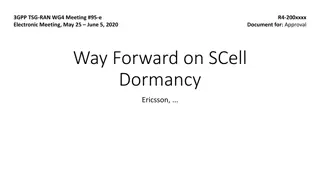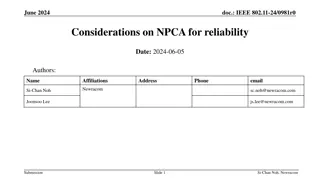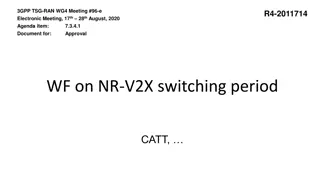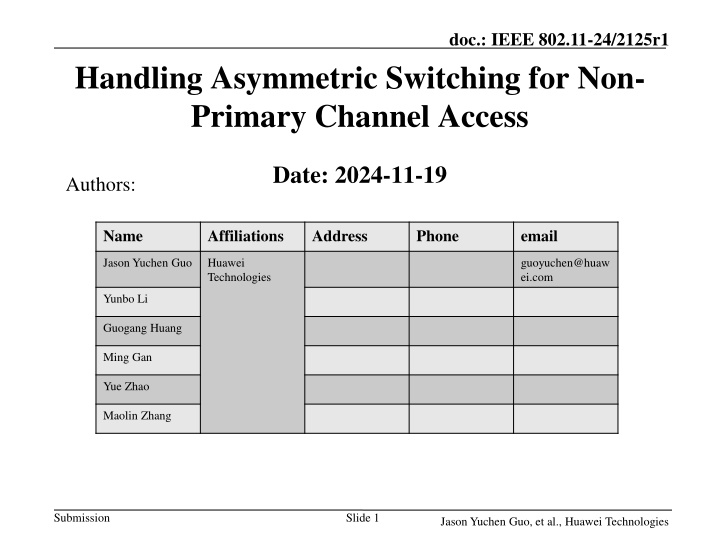
Handling Asymmetric Switching for Non-Primary Channel Access in IEEE 802.11-24/2125r1
Explore the concept of Non-Primary Channel Access (NPCA) mode in TGbn that allows STAs to access secondary channels when the primary channel is congested. Learn about the challenges of asymmetric switching based on different channel conditions within the same BSS and proposed solutions to optimize channel utilization and reduce latency.
Download Presentation

Please find below an Image/Link to download the presentation.
The content on the website is provided AS IS for your information and personal use only. It may not be sold, licensed, or shared on other websites without obtaining consent from the author. If you encounter any issues during the download, it is possible that the publisher has removed the file from their server.
You are allowed to download the files provided on this website for personal or commercial use, subject to the condition that they are used lawfully. All files are the property of their respective owners.
The content on the website is provided AS IS for your information and personal use only. It may not be sold, licensed, or shared on other websites without obtaining consent from the author.
E N D
Presentation Transcript
doc.: IEEE 802.11-24/2125r1 Handling Asymmetric Switching for Non- Primary Channel Access Date: 2024-11-19 Authors: Name Affiliations Address Phone email Jason Yuchen Guo Huawei Technologies guoyuchen@huaw ei.com Yunbo Li Guogang Huang Ming Gan Yue Zhao Maolin Zhang Submission Slide 1 Jason Yuchen Guo, et al., Huawei Technologies
doc.: IEEE 802.11-24/2125r1 Introduction TGbn has decided to define NPCA mode which enables a STA to access the secondary channel while the primary channel is known to be busy due to OBSS traffic or other TBD conditions. NPCA can improve channel utilization when the NPCA primary channel is not occupied by the OBSS transmission, and also reduces latency since it offers more opportunities to use the channel. However, due to the nature of the wireless transmission, different STAs will see different OBSS transmissions in the air, and we should try to ensure that the transmitter and the receiver switch to the NPCA primary channel synchronously to obtain the above benefit. Submission Slide 2 Jason Yuchen Guo, et al., Huawei Technologies
doc.: IEEE 802.11-24/2125r1 Asymmetric Switching Due to different channel conditions, different STAs in the same BSS may decode an OBSS packet successfully or unsuccessfully. In that case, some STAs may switch to the NPCA primary channel, while others may not. Example 1 - Non-AP STA switches, AP does not switch If a non-AP STA is closer to the transmitter of the OBSS packet while the AP is relatively far, the non-AP STA may switch to the NPCA primary channel, and the AP may still park on the primary channel Motivation: If the non-AP STA knows that the AP does not switch, it should also stay on the primary channel: It can receive some short packet from the AP; It can perform SR transmission if conditions satisfy OBSS Packet Non-AP STA Non-AP STA AP AP OBSS AP OBSS non- AP STA Submission Slide 3 Jason Yuchen Guo, et al., Huawei Technologies
doc.: IEEE 802.11-24/2125r1 Asymmetric Switching Due to different channel conditions, different STAs in the same BSS may decode an OBSS packet successfully or unsuccessfully. In that case, some STAs may switch to the NPCA primary channel, while others may not. Example 2 AP switches, non-AP STA does not switch If the AP is closer to the transmitter of the OBSS packet while a non-AP STA is relatively far, the AP may switch to the NPCA primary channel, and the non-AP STA may still park on the primary channel Motivation: If the AP knows that the non-AP STA does not switch, it should avoid transmitting to that non-AP STA when performing NPCA OBSS Packet Non-AP STA Non-AP STA AP AP OBSS AP OBSS non- AP STA Submission Slide 4 Jason Yuchen Guo, et al., Huawei Technologies
doc.: IEEE 802.11-24/2125r1 Solution In order to solve the issue in example 1: AP can announce a list of MAC addresses of OBSS STAs, where the AP switches to the NPCA primary channel when receiving the packets from those OBSS STAs Non-AP STAs will only perform NPCA when receiving OBSS packets transmitted from those OBSS STAs Simplified solution: Because OBSS STAs can be moving, it is difficult for the AP and non-AP STAs to manage the list of OBSS STAs in a timely manner. To simplify the solution, the AP can just announce a list of MAC address of OBSS APs (or BSS colors of those APs) Non-AP STAs will only perform NPCA when receiving OBSS packets with RA/TA matching any of the MAC address (or BSS color) in the list Submission Slide 5 Jason Yuchen Guo, et al., Huawei Technologies
doc.: IEEE 802.11-24/2125r1 Solution In order to solve the issue in example 2: Non-AP STA also needs to indicate to the AP: a list of OBSS STA MAC addresses During NPCA, AP will only transmit to the non-AP STA if the NPCA is performed due to an OBSS packet transmitted by one of those OBSS STAs A simplified solution could also be: The non-AP STA indicates a list of OBSS AP MAC address or BSS colors Submission Slide 6 Jason Yuchen Guo, et al., Huawei Technologies
doc.: IEEE 802.11-24/2125r1 Conclusion We consider the asymmetric channel switching issue in the NPCA We can reduce the asymmetric channel switching by announcing the MAC address/BSS color of OBSS STAs/APs whose transmissions cause the NPCA Submission Slide 7 Jason Yuchen Guo, et al., Huawei Technologies
doc.: IEEE 802.11-24/2125r1 SP Do you support to include in the 11bn SFD: AP can announce a list (or bitmap) of BSS colors, where the AP and its associated STAs switch to the NPCA primary channel only when receiving the OBSS packets from the BSS(s) whose BSS color is in the list (or indicated as 1 in the bitmap) Submission Slide 8 Jason Yuchen Guo, et al., Huawei Technologies
doc.: IEEE 802.11-24/2125r1 References [1] 11-23/34, Non-primary channel utilization, Sindhu Verma [2] 11-23/1414, Secondary channel usage follow up, Liwen Chu [3] 11-23/961, UHR secondary channel access, Minyoung Park [4] 11-23/797, Non-primary channel access, Yongho Seok [5] 11-23/1891, Nonprimary channel access - follow up, Gaurang Naik Submission Slide 9 Jason Yuchen Guo, et al., Huawei Technologies



